-
Communication
Sending a Message to Another Person
For over a year, I have been sending emails to my sister in Arizona and getting no response. Recently, I contacted my brother via Facebook, and he told me she no longer had an Internet connection. This stumped me. How was I to get a message to her? I pondered for a while, until my wife said, “Why don’t you write her a letter.”Of course.
Once humanity learned to write, letters replaced smoke signals as the primary method of sending a message from one person to another. Even today they remain a viable—if antiquated—option. Although recent history has demonstrated that the speedier the communication, the more popular it becomes, up until the 1840s, there was nothing faster than a horse, so ink and paper remained the only way to send a message for thousands of years. Then came telegraphs (the original point-to-point text messaging systems), and no horse was faster than the speed of electricity (which is essentially the speed of light, or 186,282 miles per second—take note, there will be a quiz later).
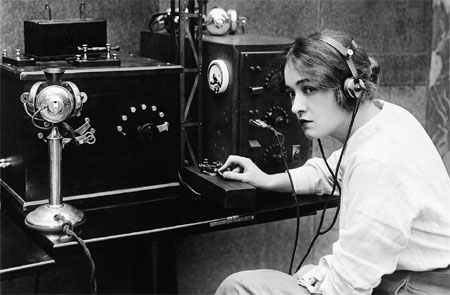
Telegraph Operator From then on, people with the resources, access, knowledge and desire, could send a message, instantaneously, to anyone, anywhere in the world, provided they, too, had the resources, access, knowledge and desire, as well as a hard-wired connection.
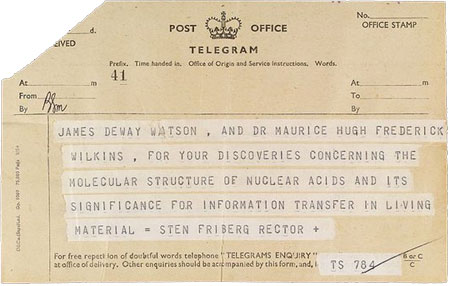
A Telegram. These were around in my day, and for all I know they may still be, but I have never sent nor received one. The telephone—invented in the late 1800s—took a while to catch on, but by the time I was born, it was the most popular way of communicating. Within your area code, that is. I lived in the 518 area code, in northeastern New York (our phone number was Murdock 4-1931), so if I wanted to get a message to someone farther away, I needed to write a letter.
You could, naturally, call outside your Area Code, but it was not straightforward, and it cost money. Therefore, I wrote letters, and almost all of them were to Pen-Pals.
I had a series of Pen-Pals from the time I was nine or ten, until around the age of fifteen. I can’t honestly say how I found them. There must have been a directory of some sort, which listed kids brave enough to put their names and addresses out there, hoping to connect with someone. I do recall scanning a list of addresses and sending letters to those that looked promising. A handful wrote back and, of them, about three or four developed into long-time correspondents.
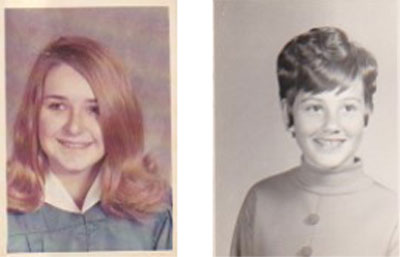
Janet and Angela, two of my Pen-Pals With the technology and diversions available today, it is impossible to convey how exciting that was, to share your world with another person, and to hear about theirs in return. And my Pen-Pals weren’t even in other countries; they were all in the US, though one was in California and another in Texas, so they might as well have been in Timbuktu. It gave me something to look forward to in a world where very little happened, and it was good practice.
Letter writing was a necessary skill back then. It was taught in school, and mastering the forms—business letter, personal letter, professional correspondence—was something you needed to achieve if you were to make it in the world.
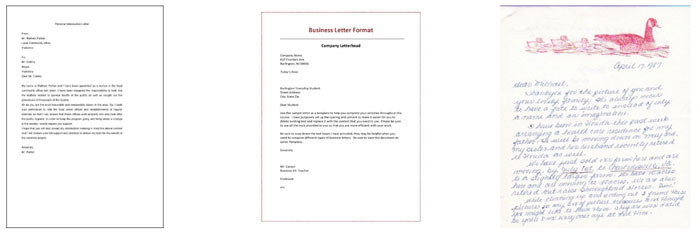
Personal Letter – Business Letter – Family Letter This remained the status quo until the adoption of electronic communications. Email was invented in 1971, but the first I became aware of point-to-point, instant communication was around 1977, when I was working as a DEMO (Data Entry Machine Operator) for New York State. I had joined as a Keypunch Operator in 1976, but Keypunch was already obsolete at that time, and I soon found my job phased out. The Keypunchers were then scattered around the building to enter data on rudimentary CRTs.
(NOTE: I realize I am using a lot of antiquated phrases and jargon. I will elucidate on these at another time.)
I recall sitting in a dim, empty office, tapping away (I worked the midnight shift back then) when a line of text—a message from a co-worker—popped up on my screen. It turned out, if you entered the machine’s address code, wrote a message, and pressed the Enter key, that message would be delivered to that CRT. Suddenly, I was back in contact with my workmates, and we could chat away to our heart’s content, as long at the supervisor didn’t catch us. Needless to say, this discovery decreased boredom, eradicated loneliness, and brought production to a halt. But it was an exciting revelation.
It was also short-lived. We were soon gathered into a new unit, with updated CRTs, where we could chat and work at the same time. You could still communicate between machines, but the need was no longer there.
Years later, around 1987, an in-house, home-grown email system became available. It was basic, unintuitive, and used mainly by supervisors, because upper management still had secretaries to type their memos, and the workers in the trenches didn’t need email.
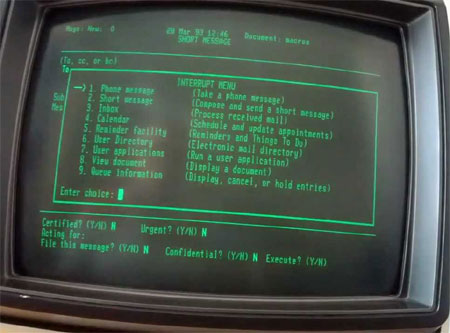
Early Email As the office slowly became wired up to a LAN, actual, commercial email became available. To everyone. Naturally, the first thing management did was to try to keep it out of the hands of the proletariat. It was, of course, a losing battle. After a fight, they gave in, everyone got email, and immediately began misusing it:
MESSAGE: (Send to ALL) Happy Birthday to Melissa in the Fax Unit! 3O YEARS OLD TODAY. AGAIN!!!!!!! LOL!!!!
MESSAGE: (Reply to ALL) Happy Brithday Melissa!!!!!!!!!!!!!!!
MESSAGE: (Reply to ALL) MONY HAPPY RETURNS! DRINKS AT SUTTER’S LATER???
MESSAGE: (Reply to ALL) Melissa, Happy B-DAY!!!!!
MESSAGE: (Reply to ALL) Happy Birthday, Melissa. Have good one!
MESSAGE: (Reply to ALL) Happy Birthday Melissa. 30 yars od again! HA! : )
MESSAGE: (Reply to ALL) Happy Birthday, Melissa. =)
MESSAGE: (Reply to ALL) WILL YOU PLEASE STOP HITTING “REPLY TO ALL”!!!!!
MESSAGE: (Reply to ALL) Happy Birthdy Melissa. See you at Sutter’s!!!!!!
MESSAGE: (Reply to ALL) Happy Birthday! ******HUG********
MESSAGE: (Reply to ALL) WILL YOU PLEASE STOP HITTING “REPLY TO ALL”!!!!!
MESSAGE: (Reply to ALL) Happy Birthday Melissa!!!!!!!!!!!!!!!
MESSAGE: (SEND to ALL) This is LAN Management. If you continue to clog up the system like this, you will be barred from using email.
MESSAGE: (Reply to ALL) Are we meeting at Sutter’s, or what????You get the idea.
Radical though it was, Email remained, at its heart, a letter sent electronically, which does not count as innovation. It’s more akin to paving a cow-path. A medium such as the Internet holds infinite possibilities, and these soon came to the fore.
Text was used for the first time on 3 December 1992. The message was “Merry Christmas,” and it was quite an event, but it didn’t impact my life. As far as I’m aware, texting wasn’t something we did in the States until after I left in 2002. Since then, of course, the electronic landscape has change dramatically. The leader of the new revolution, which I am certain you have all heard about and are very familiar with, because it’s sorta like “Who was the first guy to walk on the moon,” was MySpace.
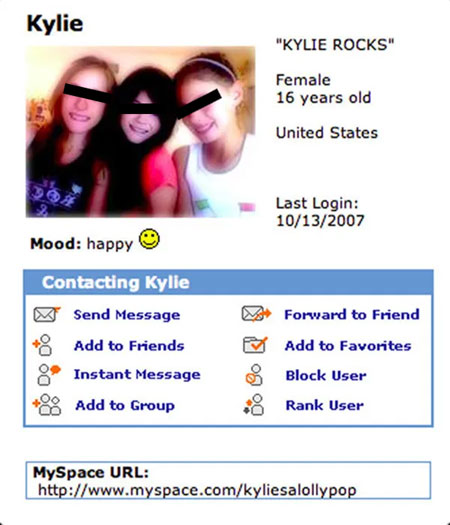
MySpace Page MySpace erupted in 2003, and was an instant hit. Everyone and their grandmother had a MySpace page. Then, just as suddenly as it arrived, it disappeared, to be replaced, in 2004, by FaceBook.
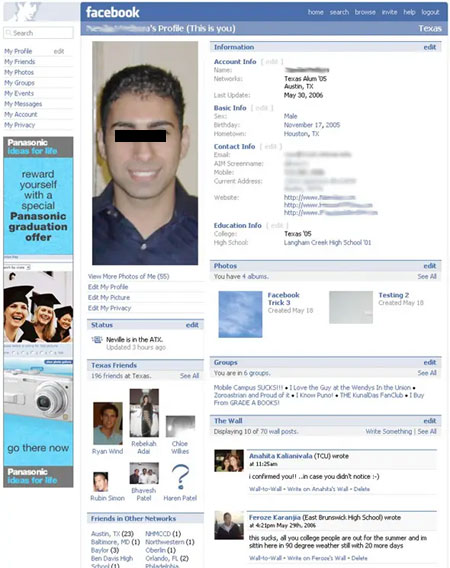
Old-style FaceBook Page (HISTORICAL NOTE: MySpace is still around, but it is mostly used for the sharing of music, or so I am told.)
FaceBook was the happening place until the people who used it stopped posting photos of raucous nights out and began uploading short videos of the latest cute thing their grandchildren did.
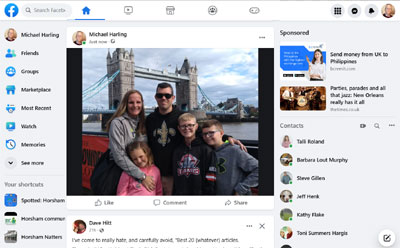
Current FaceBook Page Twitter, once a fun place to chat with friends (I wouldn’t know, I hardly ever used it) has devolved into a 450-million-strong bun-fight, leaving WhatsApp as a favoured method of electronic communication: it’s free, you can send messages, photos, videos, and make face-to-face Jetson-type calls to anyone else on the network.
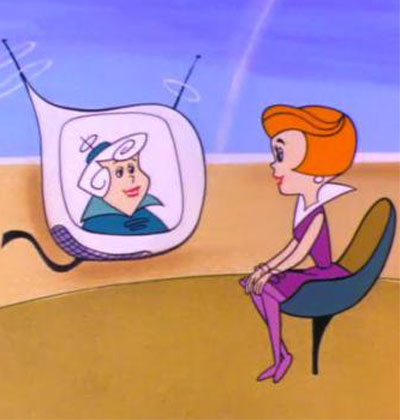
They predicted this in 1962 for 2062, but it only took 50 years And this is where things stand at the moment: I am au fait with WhatsApp, and—SnapChat, TikTok, Viber, Skype, and the like aside—content to use email.
And, when the need arises, I can still—because I was taught how—write a letter when required.
(Interesting but unrelated fact uncovered while doing the usual slap-dash research for this piece: SnapChat was initially released in September of 2011. By November 2012, users had shared over one billion photos, with 20 million photos being shared per day. And I have no knowledge, or even understanding, of what SnapChat is or does. And I like it that way.)